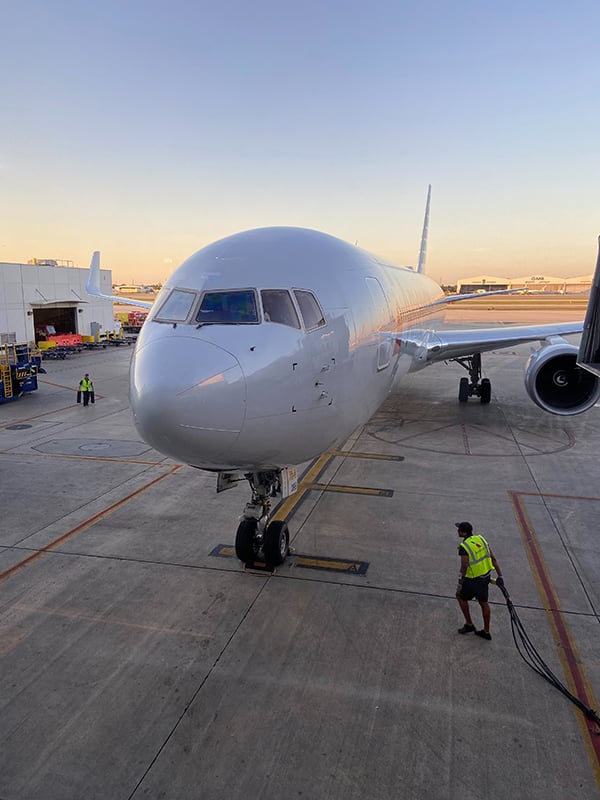What Is Predictive Risk Management?

In aviation safety management systems (SMS), risk management professionals toss around three common terms:
- reactive risk management;
- proactive risk management; and
- predictive risk management.
To avoid confusion, aviation safety professionals need to be clear about the different types of risk management activities and use these terms accordingly.
Predictive risk management in aviation SMS is the process of performing risk management activities on potential/hypothetical hazards, risk events, and/or consequences based on evaluating historical performance.
“Potential” and “hypothetical” should not be random. Predictive activities for risk management are based on:
- Normal operational data, as opposed to accident data; and
- Potentialities that have not already occurred.
Many large online resources discuss the need to “shift” from reactive to predictive risk management. This seems to imply a false notion that predictive is a “better” form of risk management than reactive or proactive. This is simply not true.
Related Aviation Risk Management Articles
- Difference Between Reactive, Predictive and Proactive Risk Management in Aviation SMS
- How to Practice Reactive, Proactive, and Predictive Risk Management in Your Safety Program
- Difference Between Hazards, Risks & Control Measures in Aviation SMS
Misnomer About Predictive Management of Risk
It’s important to remember that when you read about “moving towards” or “shifting to” predictively managing aviation safety risk, this simply means:
- Adopting predictive activities in your risk management process; and
- Moving from sole reliance on reactive and/or proactive risk management.
Each type of risk management has an important place in your organization. Predictive risk management is used to:
- Identify safety issues that haven’t happened yet; but
- Probably will happen if unaddressed; and
- Act accordingly by updating risk control strategies.
The process of predictively managing risk is done through predictive activities.
What Are Predictive Risk Management Activities

Perhaps the three most common predictive activities for risk management are:
- Management of change;
- Trend analysis; and
- Safety cases.
These activities are commonplace in mature aviation SMS and involve:
- Accumulating and classifying safety report data;
- Analyzing current operations;
- Identifying new hazards;
- Identifying new risks;
- Implementing controls to prevent these potentialities;
- Analyzing controls for "substitute risk;" and
- Identifying trends.
Some common risk management tools that aid in predictive activities are:
- Bowtie analysis;
- Shortfall analysis;
- Inspections;
- Aviation safety audits; and
- Trending charts.
Related Aviation SMS Trend Analysis Articles
- Aviation Safety Managers' Best Friend - Trending Charts
- How to Prepare Data for Trend Analysis in Risk Management Programs
- Six Steps How to Perform Trend Analysis in Aviation SMS
How Predictive Is Different From Reactive Risk Management
Reactive risk management is the process of addressing safety events after they occur. This is understood in two different ways by different parts of the organization:
- Management: acting in response to submitted safety issues; and
- Employees: acting in response to a hazardous condition in the environment.
The second point is extremely important and one that you will rarely see discussed. Risk management is not just for safety management teams and upper-level managers but for all employees in different ways.
How Proactive Is Different From Reactive Risk Management
Proactive risk management involves identifying precursors to risk based on accumulated safety data, such as leading indicators. For employees, proactive risk management activities involve identifying and reporting root causes and other precursors to risk events/hazardous conditions.
Predictive management of risk is unique from these other forms of risk management in that:
- It does not directly use safety data from incidents;
- It is not a “response” to anything (such as to data or incidents); and
- It is primarily a management process, whereas proactive/reactive processes are practices by both employees and management alike.
In short, managing risk predictively is kind of a stand-alone, disjointed process. Reactive and proactive activities are intimately tied together. Predictive management has more specific uses.
Related Predictive Risk Management Articles
- How to Do Predictive Risk Management Data Mining in Aviation SMS
- How Aviation Safety Managers Reach Predictive Analysis Phase
- 3 Ways to Practice Predictive Risk Management
What Your Aviation SMS Needs to Be Predictive
New aviation SMS implementations will have a hard/impossible time performing predictive risk management activities. This is because they lack the essential ingredients that are needed for the predictive process, such as:
- Substantial and relevant historical data to support predictive findings;
- Documented policies and procedures to analyze;
- Well-developed, repeatable risk analysis techniques; and
- Time, manpower, and resources needed to spend time on predictive activities.
The long and short of it is that you need a well-implemented SMS before considering devoting resources to practice predictive risk management activities. Otherwise, your time, resources, and energy are better spent on SMS implementation and strengthening your safety culture rather than on predictive analysis.
Plans to Acquire and Store Supporting SMS Data

If you are managing the aviation SMS implementation using paper and spreadsheets, you will need to reconsider your SMS data management strategy. In short, you will not reap the benefits of reducing losses and improving aviation safety at your organization using predictive risk management techniques. You need data.
Having data is great but this data must be in a form that can be easily aggregated, sorted, filtered, and analyzed. An aviation SMS' scope is broad and covers multiple systems, including, but not limited to:
- Safety reporting system;
- Risk management system;
- SMS training system;
- Safety goals and objectives tracking system; and
- SMS performance monitoring system.
Aviation SMS implementations have onerous documentation requirements. Collecting and analyzing data from the various systems can become overwhelming when the organization becomes too reliant on spreadsheets.
Data Management for Predictive Risk Management
A common challenge faced by many smaller and mid-size operators is that they have become reliant on spreadsheets, email, and paper as their core SMS data management strategy. These data types are short-term data storage media, while a database is an appropriate technology to store and retrieve data for long-term projects, such as an SMS.
There are a few low-cost, commercially available SMS database solutions that will make your SMS more:
- Sustainable;
- Audit worthy; and
- Professional.
We might summarize predictive management of risk as a luxury of mature safety management systems using robust SMS databases to manage lots of collected safety data.
If you have spreadsheets containing enough data to analyze over a prolonged period, you can still participate in predictive risk management activities. However, your endeavor will not be sustainable. The effort to aggregate data and develop meaningful reports year after year becomes the "dreaded annual activity." Even today, there are safety professionals who spend at least three weeks each year preparing managerial reports that may or may not be useful in reducing risk.
If you find yourself dreading the "annual reports," then an SMS database that has predefined reports is the answer.
Related Aviation SMS Database Articles
- What Is an Aviation Safety Database
- How to Choose the Best Aviation Safety Database Software
- 3 Things to Know Before Buying Aviation SMS Database
Final Thoughts on Predictive Risk Management
Predictive risk management is an expectation by regulatory agencies. After all, the FAA claims the objective of aviation SMS is to
- proactively manage safety,
- identify potential hazards,
- determine risk, and
- implement measures that mitigate the risk.
The FAA envisions operators being able to use all of the components of SMS to enhance a carrier’s ability to identify safety issues and spot trends before they result in a near-miss, incident, or accident. For this reason, the FAA is requiring carriers to develop and implement an SMS. (emphasis added).
Federal Register / Vol. 80, No. 5 / Thursday, January 8, 2015 / Rules and Regulations
Predictive risk management is about identifying the precursors to disastrous events and implementing controls to mitigate identified risks. Do you have a long-term SMS data management strategy that facilitates predictive risk management activities? If not, we can help.
SMS Pro has been working with aviation service providers since 2007. If your SMS data management strategy does not accommodate long-term data analysis, you may want to reconsider how you manage your aviation SMS documentation requirements.
Robust, user-friendly SMS databases are relatively inexpensive compared to missed opportunity costs as well as the additional labor required to manage spreadsheet and paper-based SMS strategies.
If you want to start implementing predictive management of risk, but are still bogged down in implementation, see this implementation checklist.
Last updated December 2025.









